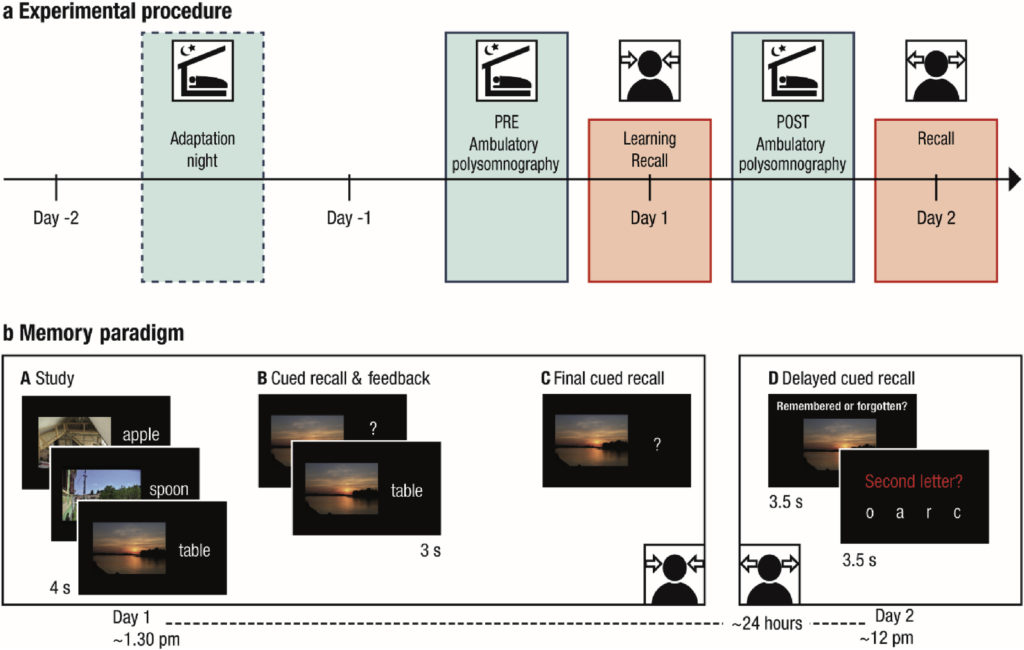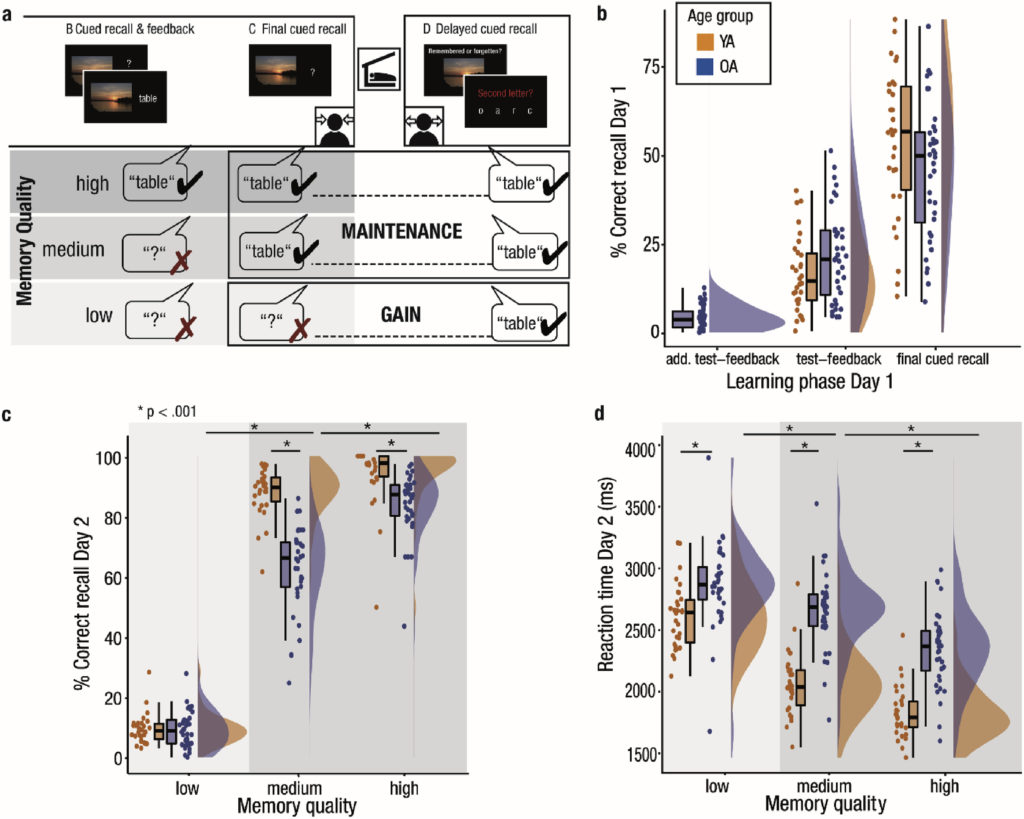Brain Structure Changes, Memory Quality, and Memory Storage in Aging
Neuroscientists demonstrated intermediate-quality memories, as opposed to high quality or low-quality memories, have reduced formation (consolidation) for long-term storage in the brain during non-rapid eye movement sleep (NREM sleep) in aged individuals compared to younger individuals.
Neuroscientists Studying Effects of Aging on Memory Provide Evidence Brain Structure Integrity and Quality of Acquired Memories in Different Age Groups Affect Memory Formation During Sleep

Humans have two types of sleep: rapid eye movement (REM) sleep and non-rapid eye movement (NREM) sleep. Different brainwaves (waveforms) and neural activity characterize these two types of sleep. Memory formation (consolidation) of information the brain acquires during the day requires sleep. In fact, long-term retention of information the brain acquires during wakefulness necessitates non-rapid eye movement sleep (NREM). During sleep, an interplay of slow brainwave (waveform) oscillations and bursts of neural oscillatory activity (sleep spindles) facilitate memory formation (consolidation) for long-term storage in the brain. Memory formation (consolidation) entails labile memory traces in the middle of the brain (hippocampus) transforming into more durable and permanent representations in the region of the brain involved in higher order function (the neocortex). To date, evidence from research does not provide conclusive data regarding through what means aging affects memory formation (consolidation).
Several previously-published studies suggested that sleep benefits memory for autobiographical events (episodic memory) and that aging reduced these beneficial effects. In relation to these studies, Sonni and Spencer (2015) showed that visuospatial memories had protection from interference in older and younger adults when those studied had an opportunity to sleep. Most notable, a reduction or absence of this protection of memories from sleep occurred in low-performing older adults.

The depth of memory acquisition (encoding) and degree of learning distinguished memories regarding their strength and quality. Generally speaking, shallow processing of new information seemed to impair learning success in old age. It seemed likely sleep did not affect sleep-dependent memory formation (consolidation) of all acquired (encoded) memories in the same way. Several studies provided evidence that the brain prioritizes intermediate quality memories during sleep, which would have resulted in greater benefit for weakly acquired (encoded) memories. Therefore, determining effects of age on memory acquisition (encoding) during sleep required consideration of quality of memories.
Another aspect affecting memory acquisition (encoding) and formation (consolidation) entailed brain structural integrity. Important brain structures for memory acquisition (encoding) and memory formation (consolidation) for long-term storage in the brain included an area in the middle of the brain (the hippocampus). Thus, structural integrity of this region may have played a role in memory acquisition (encoding) and memory formation (consolidation) during sleep. Reduced structural integrity of this region might have facilitated problems with memory acquisition (encoding), memory formation (consolidation), and memory recall (retrieval). Moreover, structural changes in brain regions that generate slow-wave brainwaves (slow-wave oscillations) and bursts of neural oscillatory activity (sleep spindles) during sleep may have induced problems with memory formation (consolidation) for long-term storage in the brain. This may have lead to altered sleep physiology in old age as well. For example, a region toward the front of the brain (medial prefrontal cortex), a region particularly vulnerable during aging, has been linked to reduced production and coordination of low-frequency brainwaves (oscillations) with associated reductions in memory formation (consolidation). Hence, brain structure problems and atrophy of the brain in old age may have associated with impairments in memory formation (consolidation) through altered ability of the brain to induce the slow-wave sleep stage.
Aging indeed associated with disruptions in non-rapid eye movement (NREM) sleep. Sleep patterns became fragmented in older age as well. Daytime fatigue ensues with older age along with increased need for daytime naps. Furthermore, compared to younger individuals, older people have had shorter slow-wave sleep durations. Perhaps the most important stage of non-rapid eye movement (NREM) sleep, slow-wave sleep, constitutes the deepest part of non-rapid eye movement (NREM) sleep. These complications with sleep in older age may have resulted in decreased protection of memories in the older population. In other words, complications in sleep physiology may have resulted in older people forgetting things more often.
Muehlroth et al. (2019) performed a study whereby they tracked learning of scene-word associations in older and younger adults. They proposed (hypothesized) that the age differences in memory consolidation were most prevalent in intermediate-quality acquired (encoded) memories. As mentioned, the intermediate-quality memories appeared to preferentially go through formation (consolidation) for long-term use in the brain during sleep. The group also proposed (hypothesized) the differences in non-rapid eye movement (NREM) sleep explains the higher level of forgetfulness in the older population. The researchers also proposed (hypothesized) that deficiencies in brain structure integrity in older age could have associated with problems in memory formation (consolidation).
The results of the study demonstrated that age-related memory formation (consolidation) deficiencies were greatest for maintenance of patterns of associations (mnemonics) of intermediate acquisition (encoding) quality. Muehlroth et al. (2019) gave a proposed explanation of this saying that strongly acquired (encoded) memories did not undergo formation (consolidation) for long-term storage in the brain during sleep since that process would have been redundant. Memories with intermediate quality, on the other hand, might have had necessary strength to prioritize them in the brain yet not sufficient strength to have made the process of memory formation (consolidation) during sleep redundant. Since older individuals had disrupted memory formation (consolidation) during sleep, this may have explained their age-related deficits in intermediate-quality memories compared to younger participants. In essence, these results indicated that the pre-sleep level of memory acquisition (encoding) affected quality of the memory and how well the memory formed (consolidate) for long-term storage in the brain during sleep.
Regarding structural integrity measurements, Muehlroth et al. (2019) found that participants with lower brain structure integrity displayed a more ‘aged’ sleep profile with a shorter slow-wave sleep stage of non-rapid eye movement (NREM) sleep. Muehlroth et al. (2019) also found reduced brain structure integrity facilitated reduced maintenance of intermediate and high-quality memories. Thus, the study provided evidence age differences in non-rapid eye movement (NREM) sleep physiology and brain structure integrity associated with age-dependent differences in memory formation (consolidation) during sleep. Future studies should consider quality of memory acquisition (encoding) when measuring differences in memory formation (consolidation) for long-term storage as the study provided evidence that the brain preferentially formed (consolidated) intermediate-quality memories for long-term use.

